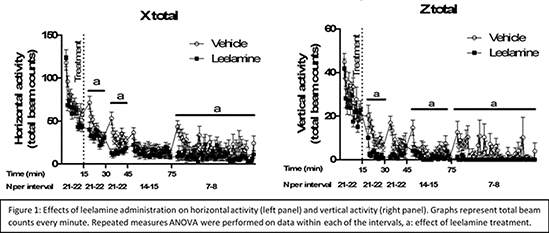| 006P London, UK 8th European Workshop on Cannabinoid Research |
Leelamine, a low affinity CB1 receptor ligand, has cannabinoid-like behavioural effects in rats
Introduction: Leelamine ([(1R,4aS,10aR)-1,4a-Dimethyl-7-propan-2-yl-2,3,4,9,10,10a-hexahydrophenanthren-1-yl]methanamine) is a diterpene amine found in the pine tree1,2. In recent years, leelamine has been investigated for its anticancer activity in melanoma3. However, it was first discovered as a low-affinity CB1 receptor (CB1R) ligand4. The aim of the present study was to further assess the cannabinoid-like pharmacological properties of leelamine in behavioural and radioligand binding studies.
Method: Male Sprague-Dawley rats (250-300g) were injected intraperitoneally with 25mg/kg leelamine or vehicle (1:1:18, ethanol:cremophor:saline) at time-point 0. At time-points (minutes) -15, 15, 30, 60 and 120 animals were tested in the hot-plate test (55°C±1) and their core body temperature was measured with a rectal probe. To measure catalepsy, a bar test was performed at time-point 15. Locomotor activity was assessed using a photo beam break system during the intervals between behavioural tests and injection. Binding experiments with [3H] leelamine and its displacement by either unlabelled leelamine or the cannabinoid receptor agonist CP55,940 were conducted using whole brain membranes from CB1R knockout mice. 10-12 μg of protein were incubated with 1200-1600cpm (80-105pM) of [3H]leelamine for 30 minutes. Bound and free radioligand were separated by centrifugation, and quantified using scintillation counting.
| Table 1: Results are express as Veh (mean±SEM) vs leelamine (mean±SEM). Number of animals treated with Veh-Leelamine is shown in parentheses. Student’s t-test * P<0.05 veh vs leelamine. | |||||
| Time-points (minutes, relative to leelamine or vehicle injection) | |||||
| Measurements | -15 | 15 | 30 | 60 | 120 |
| Latency to first hind paw lick (s) | 17.60±1.63 vs 19.72±1.47 (20-21) | 21.49±1.57 vs 31.21±1.88 (20-20) * | 17.37±1.67 vs 28.28±2.39 (21-21) * | 16.28±1.82 vs 23.76±2.41 (14-14) * | 13.64±2.08 vs 20.62±3.46 (7-7) |
| Core body temperature, change from baseline (°C) | 1.11±0.21 vs 0.143±0.19 (20-21) * | 0.85±0.19 vs -0.26±0.22 (20-22) * | 0.63±0.34 vs -1.49±0.41 (14-15) * | 0.83±0.36 vs -2.14±0.47 (7-8) * | |
Results: Acute administration of leelamine induced a significant antinociceptive effect, increasing the latency to hind paw lick in the hot-plate test during the first 60 minutes after leelamine administration (Table 1). Throughout the trial duration (120 minutes), leelamine-treated rats had significantly lower core body temperature (Table 1) and locomotor activity effect (Figure 1), compared with vehicle-treated controls. However, no significant effects were found in the bar test (1.63±0.21s vs 2.06±0.33s; N=18-22). In brain membranes from CB1R knockout mice, [3H]leelamine exhibited specific binding and homologous displacement by unlabelled leelamine, but not by CP55,940.

Conclusions: The low affinity CB1R ligand leelamine exhibits cannabimimetic behavioural effects, but also binds to a site distinct from CB1R. Further research is needed to determine the identity of the non-CB1R binding site and whether it is involved in the behavioural effects of leelamine.
Acknowledgements: Funding from the Wellcome Trust, theIrish Research Council and the National University of Ireland Galway isgratefully acknowledged.
References:
(1) Devane WA et al. (2007). In Obreza A (ed). 5th Joint Meeting on Med Chem. Slovenian Pharmaceutical Society: Slovenia, pp84.
(2) Gowda R, et al. (2014) Mol Cancer Ther. 13: 1679-1689.
(3) Kuzu OF et al. (2014). Mol Cancer Ther. 13: 1690-1703.
(4) Lovinger DM (2008). Handb Exp Pharmacol. 2008: 435-477.

